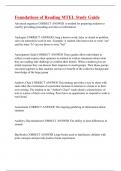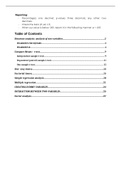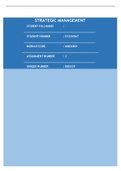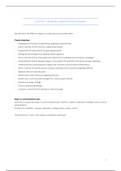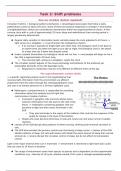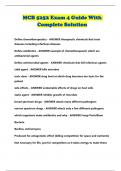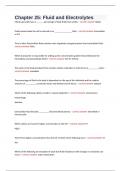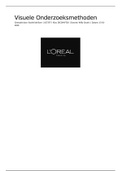Integration Lectures
Lecture 1: Semantic Memory
“meaning representation”
Artificial Intelligence assumptions:
1. If we know how a computer generates knowledge and uses it, we
will know how human memory works
2. If we know how a human memory works, we can make a super
powerful computer
A.D. de Groot
Prof Chess players were incredibly good at remembering set-ups of
the game (where the pieces are). This was due to their experience
and memory of all the previous games they had ever played -> idea
of “expert system”; the answer comes from a database of
previous knowledge
Became as good as regular students when the pieces were in places
that were not within the rules of the game
Early approaches to semantic memory
- Collins and Quillian (1969)
o Semantic memory like a library; hierarchical model that
places everything within a certain category
o “a canary has skin” takes longer to respond to than “a canary
is a bird”, because it requires to think about knowledge that is
present in a higher hierarchy (the fact that all animals have
skin)
o However, this theory makes many incorrect predictions
No explanation for “typicality effect”: a bird that is
more typical (of the concept of bird) will yield faster
response times than atypical birds (blackbird vs
penguin)
“Frequency of association” is more important than
distance in hierarchy: how often you encounter an
association is predictive of its response time
- Later version: Collins and Loftus (1975)
o “spreading activation model”
If you activate a node, the activation spreads and
nearby nodes and networks will be more easily
activated
This is the basis for priming
o Associative vs semantic priming:
Associative: priming from what’s commonly
associated; e.g., cats and dogs may prime “weather”
due to the association with the phrase “it’s raining cats
and dogs”
, Semantic: on a meaning level; e.g., “dog” primes
“Labrador”
o Semantic priming is done with Lexical Decision Task
A prime is shown with a follow up target word, subject
has to indicate whether the target is a word or not;
prime “bird”, target “robin”
Priming causes faster response time than if no prime is
present. Slower response time if prime is unrelated to
target
If subjects were told to expect a “building-related” word
after the prime “body”, this would also facilitate
their response time when done so. If then a body part
was shown, it would slow them down as to when an
unrelated target was given
Categorization (prototype vs exemplar models)
- Essential for survival of all animals
- Posner and Keele (1968); how a prototype and categorization are
created
o Study where random dot patterns are shown
(exemplars), followed by the task of categorizing new ones
as being part of the initial group or not
o We tend to make a prototype out of all the exemplars that are
given, and falsely identify the prototype as being part of
the exemplars even when this was not the case
o People do not recognize exactly which ones were or were not
part of the exemplars, but after many trials do become good
at placing them in the correct category
- The false memory task (where words are shown and have to
identify as being part of the initial sequence or not) is a similar idea,
but only shows activation of these categories, NOT the creation of
them
- Learning Regularities
o A good classification is reached after many examples (40+)
o This learning is pretty hard
o Prototype is often recognized as being “seen”, even if it was
not
o Suggests that people induce a type of prototype, do they?
o Anterograde Amnesia (episodic memory) can also learn these
types of categories; suggests implicit learning
- Prototype Theory
o The closer to the prototype, the faster the response
o But prototype has no information on:
Size of the category
Variability within category
- Exemplar Theory
o The exact opposite; “what is this?” is answered by retrieving
ALL “exemplars” from memory. Which are then compared
to the to be categorized item
, - Which theory is correct?
o Exemplar based models are considered the best
o But they make a probably wrong “remember all” assumption
o Neural networks incorporate aspects of both theories
Schemas
- Sir Frederic Bartlett (1886 – 1969)
- Idea that memory is reconstructive
o Moving toward the things we expect; when we recall
something, we basically reconstruct it with the tools we
already have (the things we already know)
o Contents of a memory is NOT preserved like an image on
a computer
o It is rather something that is reconstructed (during
retrieval) from bits and pieces of episodic memory, which
are fitted into semantic patterns (= schemas)
- Bartlett (1932) study: “war of the ghosts” story
o British students read a story from another culture
o Retell the story
Instantly after reading
Or after 3 weeks
o Results: personal background affects recall of the story.
Stronger effect after 3 weeks
o Bartlett uses the term “schema” for the semantic patterns
used to make sense of the story
E.g., “…something black came out of his mouth…” was
often interpreted and retold as “he was sick”, even
though there was no certainty given in the story that he
was sick, it just seems logical from the perspective of a
British (western) person
- Schemas help with encoding
o When are given a rather long and abstract story without
context, they are bad at recalling it
But when they are given a clue (e.g., “washing
clothes”) they become a lot better at it
o Having the correct expectations will activate the
correct schemas, which allows for interpreting everything
you read in light of that knowledge/schema
- Schemas also steer memory in a specific direction
o Leads to distortion of “true” memory
o A study on effect of schema on memory:
A row of figures is shown, two separate groups have to
draw the images from memory later on
Group 1 is given different descriptions of the figures
than group 2
Results: they draw the images according to the
descriptions of the figures
o Schemas in semantic memory distort recall!
- Brewer & Treyens study
Lecture 1: Semantic Memory
“meaning representation”
Artificial Intelligence assumptions:
1. If we know how a computer generates knowledge and uses it, we
will know how human memory works
2. If we know how a human memory works, we can make a super
powerful computer
A.D. de Groot
Prof Chess players were incredibly good at remembering set-ups of
the game (where the pieces are). This was due to their experience
and memory of all the previous games they had ever played -> idea
of “expert system”; the answer comes from a database of
previous knowledge
Became as good as regular students when the pieces were in places
that were not within the rules of the game
Early approaches to semantic memory
- Collins and Quillian (1969)
o Semantic memory like a library; hierarchical model that
places everything within a certain category
o “a canary has skin” takes longer to respond to than “a canary
is a bird”, because it requires to think about knowledge that is
present in a higher hierarchy (the fact that all animals have
skin)
o However, this theory makes many incorrect predictions
No explanation for “typicality effect”: a bird that is
more typical (of the concept of bird) will yield faster
response times than atypical birds (blackbird vs
penguin)
“Frequency of association” is more important than
distance in hierarchy: how often you encounter an
association is predictive of its response time
- Later version: Collins and Loftus (1975)
o “spreading activation model”
If you activate a node, the activation spreads and
nearby nodes and networks will be more easily
activated
This is the basis for priming
o Associative vs semantic priming:
Associative: priming from what’s commonly
associated; e.g., cats and dogs may prime “weather”
due to the association with the phrase “it’s raining cats
and dogs”
, Semantic: on a meaning level; e.g., “dog” primes
“Labrador”
o Semantic priming is done with Lexical Decision Task
A prime is shown with a follow up target word, subject
has to indicate whether the target is a word or not;
prime “bird”, target “robin”
Priming causes faster response time than if no prime is
present. Slower response time if prime is unrelated to
target
If subjects were told to expect a “building-related” word
after the prime “body”, this would also facilitate
their response time when done so. If then a body part
was shown, it would slow them down as to when an
unrelated target was given
Categorization (prototype vs exemplar models)
- Essential for survival of all animals
- Posner and Keele (1968); how a prototype and categorization are
created
o Study where random dot patterns are shown
(exemplars), followed by the task of categorizing new ones
as being part of the initial group or not
o We tend to make a prototype out of all the exemplars that are
given, and falsely identify the prototype as being part of
the exemplars even when this was not the case
o People do not recognize exactly which ones were or were not
part of the exemplars, but after many trials do become good
at placing them in the correct category
- The false memory task (where words are shown and have to
identify as being part of the initial sequence or not) is a similar idea,
but only shows activation of these categories, NOT the creation of
them
- Learning Regularities
o A good classification is reached after many examples (40+)
o This learning is pretty hard
o Prototype is often recognized as being “seen”, even if it was
not
o Suggests that people induce a type of prototype, do they?
o Anterograde Amnesia (episodic memory) can also learn these
types of categories; suggests implicit learning
- Prototype Theory
o The closer to the prototype, the faster the response
o But prototype has no information on:
Size of the category
Variability within category
- Exemplar Theory
o The exact opposite; “what is this?” is answered by retrieving
ALL “exemplars” from memory. Which are then compared
to the to be categorized item
, - Which theory is correct?
o Exemplar based models are considered the best
o But they make a probably wrong “remember all” assumption
o Neural networks incorporate aspects of both theories
Schemas
- Sir Frederic Bartlett (1886 – 1969)
- Idea that memory is reconstructive
o Moving toward the things we expect; when we recall
something, we basically reconstruct it with the tools we
already have (the things we already know)
o Contents of a memory is NOT preserved like an image on
a computer
o It is rather something that is reconstructed (during
retrieval) from bits and pieces of episodic memory, which
are fitted into semantic patterns (= schemas)
- Bartlett (1932) study: “war of the ghosts” story
o British students read a story from another culture
o Retell the story
Instantly after reading
Or after 3 weeks
o Results: personal background affects recall of the story.
Stronger effect after 3 weeks
o Bartlett uses the term “schema” for the semantic patterns
used to make sense of the story
E.g., “…something black came out of his mouth…” was
often interpreted and retold as “he was sick”, even
though there was no certainty given in the story that he
was sick, it just seems logical from the perspective of a
British (western) person
- Schemas help with encoding
o When are given a rather long and abstract story without
context, they are bad at recalling it
But when they are given a clue (e.g., “washing
clothes”) they become a lot better at it
o Having the correct expectations will activate the
correct schemas, which allows for interpreting everything
you read in light of that knowledge/schema
- Schemas also steer memory in a specific direction
o Leads to distortion of “true” memory
o A study on effect of schema on memory:
A row of figures is shown, two separate groups have to
draw the images from memory later on
Group 1 is given different descriptions of the figures
than group 2
Results: they draw the images according to the
descriptions of the figures
o Schemas in semantic memory distort recall!
- Brewer & Treyens study


